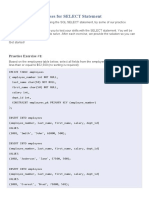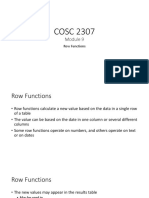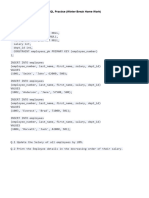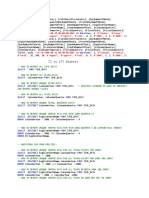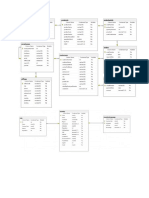0 ratings 0% found this document useful (0 votes) 41 views 9 pages (UPDATED) SQL Level 3
The document provides an overview of SQL queries and functions used in SQLite, including date and time functions, data definition language (DDL) for creating and populating tables, and examples of using constraints like primary keys and foreign keys. It also includes examples of SQL queries to calculate employee tenure, age, and customer orders, as well as the use of CASE clauses for conditional logic in queries. Additionally, it discusses altering tables and the REPLACE command for updating data.
AI-enhanced title and description
Copyright
© © All Rights Reserved
We take content rights seriously. If you suspect this is your content,
claim it here .
Available Formats
Download as PDF or read online on Scribd
Go to previous items Go to next items
Save [UPDATED] SQL Level 3 For Later 1L Bootcam| Level 3
AST:
SELECT CAST (25.65 AS varchar);
--Example 1: Calculate the number of years the employees have been working
SELECT FirstName, 2022 - CAST (HireDate AS int) AS ‘Time Working”
FROM Employee e;
Dates in SQLite:
SQLite supports 6 date and time functions. Date and time values can be stored as text
‘or numbers, Date functions include:
© DATE(time-value, modifier, modifier, ete.) + returns the date as text in this format
YYYY-MM-DD
© TIME(time-value, modifier, modifier, ete.) > returns the time as text in this format:
HE:MM:SS
« DATETIME(time-value, modifier, modifier, ete.) —> returns the date and time as text in
their same formats: YY YY-MM-DD HH:MM:SS_
JULIANDAY(time-value, modifier, modifier, etc.)
UNIXEPOCH(time-value, modifier, modifier, ete.) —r retums a unix timestamp as an
integer, the number of seconds since 1970-01-01 00:00:00 UTC
¢ STRFTIME(format, time-value, modifier, modifier, etc.) —> retums the date formatted
according to the format string specified as the first argument
© The format string supports several substitutions
+ %d day of month (00)
+ %f fractional seconds (SS:SS8)
+ %H hour (00-24)
+ %j day of year (001 — 366)
+ 4S Julian day number fractional
+ %m month (01-12)
+ %M minute (00-59)
+ %s seconds since 1970-01-01
+ %S seconds (00 - 59)
+ Yow day of week (0-6) Sunday =0
* %W week of year (00 - 53)
" %Y year (0000 - 9999)
Source: Date And Time Functions (sqlite.org)
--Compute the current date
SELECT DATE(‘now’);
--Compute the last day of the current month
SELECT DATE(‘now’, ‘start of month’, “+1 month’, ‘-1 day’) AS LastDay;
--Compute the date and time given a unix timestamp 1193961488 -> note, it does not work for
dates prior to 1970
SELECT DATETIME(1193961488, “unixepoch’);�--Compute the date and time given a unix timestamp 1092941466, and compensate for your local
timezone
SELECT DATETIME(1092941466, ‘unixepoch’, ‘localtime’);
--Compute the number of days since Canada became a country, the Dominion of Canada
SELECT ROUNDUULIANDAY (‘now’) - JULIANDAY(“1867-07-01')) AS CanadaDays;
DATEDIFF:
--How old were the employees when they were hired?
SELECT FirstName | | ~’ || LastName AS Name,
(STRFTIME(‘%Y", HireDate) - STRFTIME(‘6Y”, BirthDate)) —
STRFTIME(‘%m-%d’, HireDate) < STRFTIME(‘%0m-%ed’, BirthDate)) AS HireAge
FROM Employee e
ORDER BY BirthDate;
--How old are the employees today?
SELECT FirstName | |~’ | | LastName AS Name,
(STRFTIME(‘%Y’, ‘now") - STRFTIME(“%Y’, BirthDate)) ~
STRFTIME('%m-%d’, ‘now’) < STRFTIME('%m-"d’, BirthDate)) AS AgeNow
FROM Employee e
ORDER BY BirthDate;
--List the 4 youngest employees in the company (2 ways of querying this data)
SELECT * FROM Employee e ORDER BY BirthDate DESC LIMIT 4;
SELECT FirstName || ‘-" | | LastName AS Name,
(STRFTIME(‘%Y", ‘now’) - STRFTIME(‘%Y’, BirthDate)) —
STRFTIME('%m-%d’, ‘now’) < STRFTIME('%m-%6d’, BirthDate)) AS AgeNow
FROM Employee
ORDER BY AgeNow
LIMIT 4;
Data definition language (DDL):
First, connect to the database:�Next, set the Store] database as the active connection.�[a teanea3: ce pt
5 Oomstorne
= | Saas
—
| a |
Let’s explore how to create tables using queries.
Right click on Store! db in the database navigator and select SQL Editor and press new
SOL script.
CREATE TABLE Customers (
CustomerID INTEGER NOT NULL PRIMARY KEY,
Name TEXT,
Segment TEXT,
City TEXT,
State TEXT,
PostalCode TEXT,
Region TEXT);
Populate this table using the INSERT INTO command.
INSERT INTO Customers
(CustomerID, Name, Segment, City,State, PostalCode, Region)
VALUES
(12520,Claire Gute’, ‘Consumer’, ‘Henderson’, ‘Kentucky’, 42420’, 'South’),
(13045,'Darrin Van Hut?, ‘Corporate’ Los Angeles’ ‘California’ /90036'; West’),
(20335,'Sean ODonnell' Consumer’, Fort Lauderdale’ Florida'.'33311"/South’),
(11710,Brosina Hoffman','Consumer','Los Angeles! California’90032''West'),
(10480,'Andrew Allen’ ;Consumer’,'Concord’North Carolina’ '28027'’South’),
(15070,'Irene Maddox’ Consumer’ Seattle’ Washington’'98103',"West’),
(14815, "Harold Pawlan ', 'Home Office’, 'Fort Worth’ ,' Texas’ , '76106 ',' Central’),
(13868, ‘Darrin Van Huff, ‘Corporate’, 'San Diego’, 'California’, 90036, ‘West’);�Create Table “Orders”
Create a table for Orders
CREATE TABLE Orders (
(Order_ID VARCHAR (20) NOT NULL PRIMARY KEY
Order_Date DATE NOT NULL
Sales DECIMAL (6.2),
Quantity INT NOT NULL
Cust_ID INT NOT NULL REFERENCES Customer (CustomerID ),
Product_ID INT NOT NULL REFERENCES Products (Produet_ ID)
yy
Populate tables Orders with INSERT INTO command
insert data into table Orders
INSERT INTO Orders
(Ordet_1D,Order_Date, Sales, Quantty,Cust_ID,Produet_1D)
‘VALUES
(2019-145317, 13/18/2019, 2638.48, 12520, 'FUR-BO-10001798),
(2021-11868, "10/2/2022, 17499.95, 12520, 'FUR-CH-10000454,
¢(2022-140151', '3/23/2022, 1399.96, 13045, 'OFF-LA-10000240"
6,
5,
4
(2022127180, "10/22/2022, 1119.97, 4, 20335, 'FUR-TA-10000577),
(2022-16709, ‘11/17/2022, 10499.97, 3, 20335, ‘OFF-ST-10000760,
1B
Bs
¢2021-117121, "12/17/2021", 9892.74,” 13, 11710, | 'FUR-FU-10001487),
(2019-16904, "972322019," 9449.95, 11710, 'OFF-AR-10002833'),
Create Table “Products”
CREATE TABLE Products (
Product_ID INTEGER NOT NULL PRIMARY KEY,
Category VARCHAR(50) NOT NULL,
Sub_Category TEXT NOT NULL);
Insert data in the table Products
INSERT INTO Products
(Product_ID,Category,Sub_Category)
‘VALUES
(10001798, Furniture’ Bookcases’;
INSERT INTO Products
‘VALUES
(10002640,"Technology','Phones’),
(10000240,'Office Supplies',"Labels’),
(10000577,'Furniture',"Tables'),
(10000760,'Office Supplies',Storage'),
(10000562,"Technology’,' Phones’);
Creating tables involves the use of constraints that typically enforce rules on the data in a
table whenever a row is inserted, updated, or deleted. Examples include: not null, unique,
primary key, foreign key, check, default, create index.�CustomerID INT NOT NULL REFERENCES
Customer(Customerld), ProductID INT NOT NULL REFERENCES
Products(Productid) UNIQUE (Orderld));
--this table will ensure that the order ID is different for every order we receive from the customer
NOT NULL constrai
CREATE TABLE Products (
Productld INTEGER NOT NULL PRIMARY
KEY, Category VARCHAR(50) NOT NULL,
SubCategory TEXT NOT NULL);
Databases also need an entity relationship diagram...
Highlight the Productid column from the Products table, then drag and drop it to the
Productid column in the Orders table.
A message box will pop up to verify the attributes to create the relationship between the two
tables —> press OK.
(@ Deine vital foign bays |Oeine ital fo
be [Products
fete ie | Onde
Unene ey Onder EW Ugur
coke
(coker Coker ype af Cohen WC Type
SuPodatJO WIEGER” © Reckct OTECER
| a�‘The syntax for creating a table is as follows:
CREATE TABLE table_name (
Columni data type constraint,
Column2 data type constraint,
Column3 data_type
constraint);
‘There are 2 ways to define primary keys and foreign keys while defining a table:
[CREATE TABLE Orders (
Orderid VARCHAR(20) NOT NULL PRIMARY KEY,
OrderDate DATE NOT NULL,
Sales DECIMAL (6,2),
Quantity INT NOT NULL,
CustomerID INT NOT NULL REFERENCES Customers(Customerld),
ProductiD INT NOT NULL REFERENCES Products(Productid));
JEREATE TABLE Orders (
Orderld VARCHAR(20) NOT NULL,
OrderDate DATE NOT NULL,
Sales DECIMAL (6,2),
Quantity INT NOT NULL,
CustomeriD INT NOT NULL,
ProductiD INT NOT NULL
PRIMARY KEY (Orderld)
FOREIGN KEY (Customerid) REFERENCES Customers(Customerid)
FOREIGN KEY (Productid) REFERENCES Products(Productid));
CHECK constraint:
CREATE TABLE People (
Customerld INTEGER NOT NULL PRIMARY KEY,
Name TEXT,
Segment TEXT,
City TEXT,
State TEXT,
PostalCode TEXT,
Region TEXT, Age INT,
CHECK (Age >= 18));
~-this table will only add people who are ages 18 or
UNIQUE constraint:
CREATE TABLE Orders (
Orderld VARCHAR(20) NOT NULL PRIMARY KEY,
OrderDate DATE NOT NULL,
Sales DECIMAL (6,2),
Quantity INT NOT NULL,
der into your table�Replicate the same steps for the Customers table and Orders table to create the relationship for the
Customerld columns.
Altering tables
ALTER TABLE Products ADD
COLUMN Origin;
ALTER TABLE,
Products DROP Origin;
ALTER TABLE Products
RENAME COLUMN SubCategory TO CategoryDese;
ALTER TABLE Products DROP
CategoryDese;
REPLACE command:
‘Syntax of this function: REPLACE(string, pattern, replacement)
UPDATE Customers
SET Region = REPLACE(Region, ‘South’, ‘USA South’);
CASE Clause:
--Example I: Return all of the columns from the customer table and order them by city. When there is
no city name, order by state instead, otherwise, the values should be ordered by city
SELECT *
FROM Customers ¢
ORDER BY
(CASE WHEN
City IS NULL THEN State
ELSE City
END):
--Example 2: Write a query that returns the customer name, segment, and the state from customers
that are under the consumer category. Return a column that display the segment and state for the
consumers in North Carolina, California, Florida and all others as “Other”
SELECT Name, Segment,
CASE WHEN Segment = ‘Consumer’ AND State = ‘North Carolina’ THEN ‘Consumer NC”
WHEN Segment = ‘Consumer’ AND State = ‘California’ THEN ‘Consumer CA’
WHEN Segment = ‘Consumer’ AND State = ‘Florida’ THEN ‘Consumer FL’
ELSE ‘Others’ END AS “Segment States’
FROM Customers;
--Example 3: Suppose we have a sales volume band. Return the orders’ ID from orders that had high�volume between 15,000 and 30,000, The medium volume is between 10,000 and 13,000, and the sales
that are not in the range will return as low volume of sales
SELECT Order_ID,
CASE
WHEN Sales 5000 AND Sales <=30000 THEN ‘High Volume”
WHEN Sales >=10000 AND Sales <15000 THEN ‘Med Volume”
ELSE ‘Low Volume’
END AS ‘Sales Volume’
FROM Orders 0;
—-Example 4: Sort the customers from the South by cities in descending order. For customers from the
West, sort the city in ascending order.
SELECT Name, Segment, Region, City
FROM Customers
ORDER BY
CASE Region WHEN ‘South’ THEN City END DESC,
(CASE WHEN Region = ‘West’ THEN City END;

